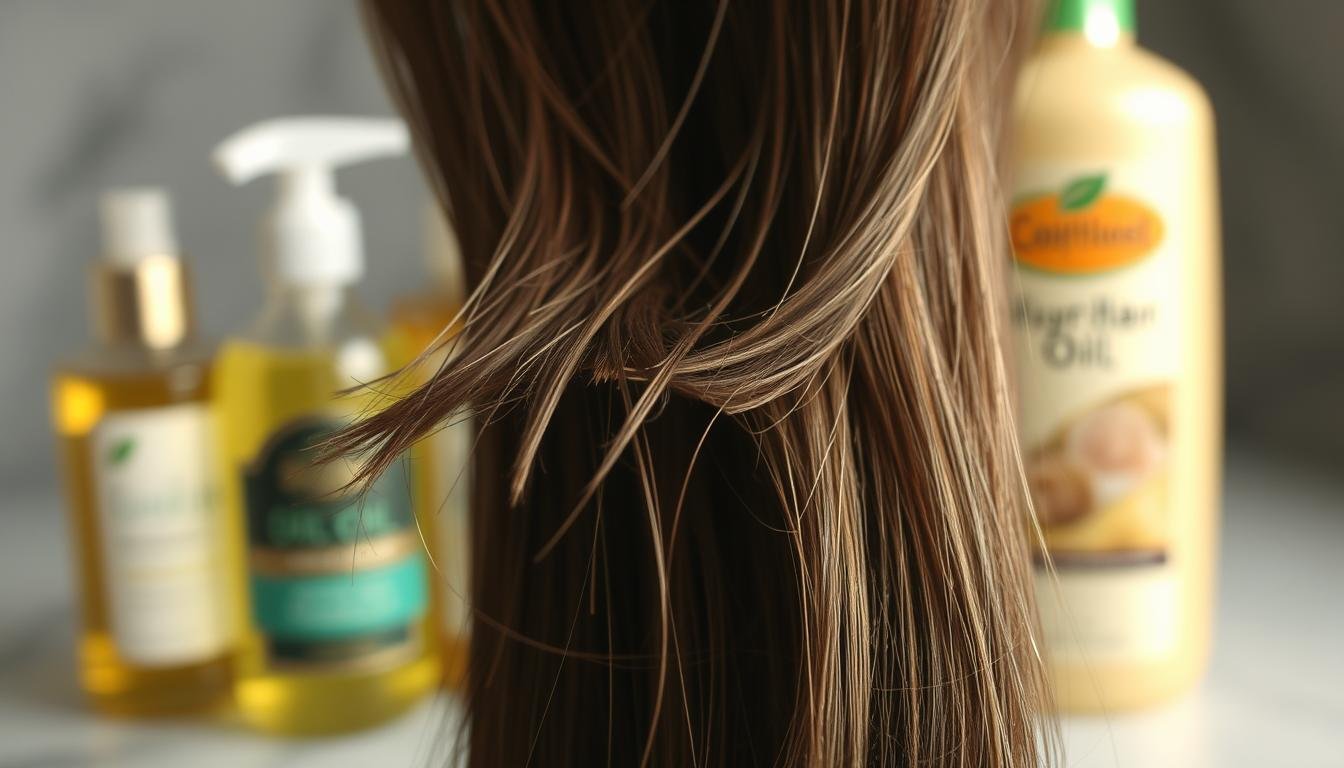What Causes Hair Damage? Top Reasons for Breakage
Did you know that a staggering 50% of women experience hair breakage on a regular basis? This widespread issue can lead to split ends, dryness, and an overall lackluster appearance. Understanding the common causes of hair damage is the first step towards restoring your locks to their former glory.
From the pH balance of your shampoo to the impact of heat styling tools, various factors can contribute to hair breakage. According to a 2014 study, certain alkaline shampoos can cause a negative charge on the hair, leading to increased friction between strands and a higher risk of breakage. Additionally, the American Academy of Dermatology advises against over-brushing hair, as this too can cause damage.
Heat treatments, such as blow-drying, straightening, and curling, can also wreak havoc on your hair, damaging the shafts and removing Essential moisture over time. Nutritional deficiencies, stress, and certain medical conditions like thyroid disorders and eating disorders can further weaken and compromise the integrity of your hair.
Key Takeaways
- Hair breakage is a common issue affecting 50% of women
- Factors like pH, over-brushing, and heat styling can damage hair
- Nutritional deficiencies, stress, and medical conditions can also weaken hair
- Proper Hair Care, including using the right products and techniques, can prevent breakage
- Maintaining a healthy lifestyle and addressing any underlying issues can help restore Hair Health
Understanding Hair Structure
To fully comprehend the intricacies of hair health and prevent damage, it’s Essential to understand the anatomy and growth cycle of hair. Hair, a defining feature of our appearance, is a complex structure that serves various functions, from insulation to self-expression.
The Anatomy of Hair
Hair is composed of three distinct layers: the cuticle, the cortex, and the medulla. The cuticle acts as the protective outer layer, shielding the inner components from external stresses. The cortex, the thickest layer, determines the hair’s strength, texture, and color. The medulla, the innermost layer, is present in thicker hair strands and contributes to the overall structure.
How Hair Grows
Hair growth follows a cyclical pattern, with three key phases: anagen, catagen, and telogen. The anagen phase is the active growth stage, lasting from 2 to 7 years. During this phase, hair rapidly divides at the root, adding length to the strand. The catagen phase, a 2- to 3-week transition period, marks the end of active growth. Finally, the telogen phase is the resting stage, where hair remains dormant for approximately 2 to 4 months before shedding.
Understanding the anatomy and growth cycle of hair is crucial for maintaining healthy, strong, and resilient tresses. By recognizing the intricate structure and dynamics of hair, individuals can make informed decisions about their hair Care Routines and mitigate the risk of damage.
| Hair Growth Cycle | Duration | Description |
|---|---|---|
| Anagen | 2-7 years | Active growth phase where hair rapidly divides at the root |
| Catagen | 2-3 weeks | Transition phase marking the end of active growth |
| Telogen | 2-4 months | Resting phase where hair remains dormant before shedding |
“By week 22 of pregnancy, babies have about one million hair follicles on the head and 100,000 on the scalp.”
The hair growth cycle is a dynamic and intricate process, and understanding its intricacies can help individuals make informed decisions about their Hair Care routine and prevent potential damage.
Common Causes of Hair Damage
Hair is a delicate part of our overall appearance, and it is susceptible to various forms of damage. Two primary culprits behind hair damage are physical damage from styling tools and chemical damage from hair treatments.
Physical Damage from Styling Tools
Using heat-based styling tools like flat irons, curling wands, and blow dryers can have a significant impact on the hair’s surface (the cuticle) and interior (the cortex). Excessive or improper use of these tools can lead to dryness, brittleness, and ultimately, hair breakage.
Chemical Damage from Treatments
Chemical treatments such as hair coloring, bleaching, perming, and relaxing can be equally damaging to hair. These processes can strip away the hair’s cuticle and natural moisture, leaving it dry, fragile, and prone to breakage.
Physical damage, caused by excessive brushing, harsh shampoos, or tight hairstyles, can also impact the cuticle layer first, leading to split ends and frizzy hair. Washing hair too frequently can strip it of natural oils, causing dryness and further damage.
Environmental factors like sun exposure, wind, and chlorine can also take a toll on hair, making it more susceptible to breakage. To prevent and address hair damage, it’s essential to use gentle styling methods, limit chemical treatments, and maintain a healthy hair care routine.
| Cause of Hair Damage | Impact on Hair |
|---|---|
| Heat Styling Tools | Dryness, brittleness, and breakage |
| Chemical Treatments | Cuticle and moisture loss, leading to fragility |
| Physical Damage | Split ends, frizz, and dryness |
| Environmental Factors | Increased susceptibility to breakage |
By understanding the common causes of hair damage, individuals can take proactive steps to protect their hair and maintain its health. This includes using sulfate-free products, limiting heat styling, spacing out chemical treatments, and being gentle with wet hair.
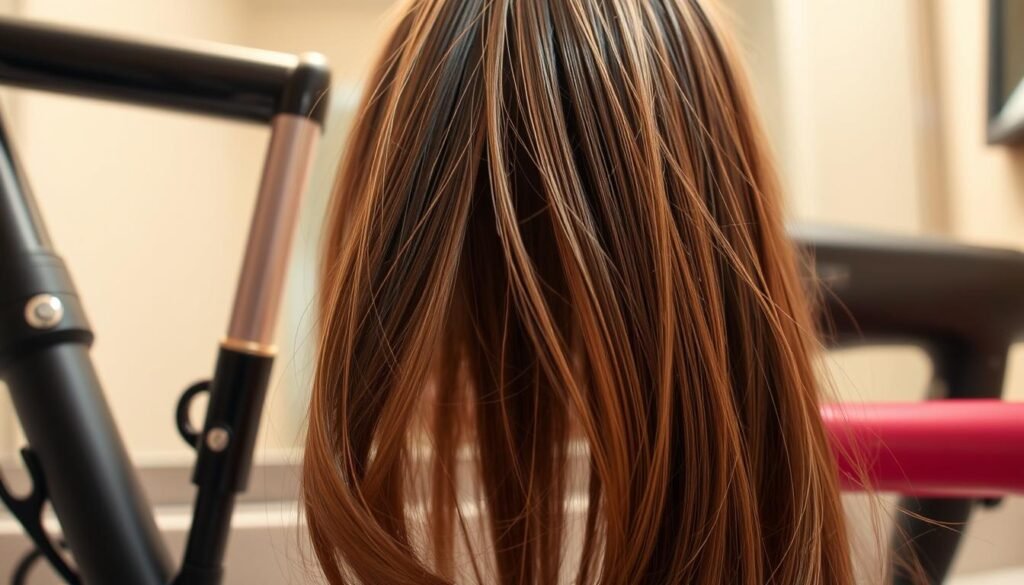
“Prevention is better than cure when it comes to maintaining healthy, vibrant hair.”
Environmental Factors
Hair is not immune to the damaging effects of our environment. From the sun’s UV hair damage to the pollution effects on hair, numerous environmental factors can take a toll on the health and appearance of our tresses.
UV Exposure and Sun Damage
The sun’s ultraviolet (UV) rays can weaken the hair’s proteins and cause discoloration. UVB radiation primarily targets the cuticle area, while UVA penetrates deeper into the cortex, leading to the loss of lipids, proteins, and melanin. This exposure can leave hair dry, brittle, and more susceptible to breakage.
Pollution and Its Effects on Hair
Environmental hair damage extends beyond sun exposure. Particulate matter (PM) and other pollutants can accumulate on the hair surface, making it appear rough and dull. Polycyclic aromatic hydrocarbons (PAHs) can also cling to the hair, causing chemical damage to the cuticle and proteins. Exposure to these environmental stressors can increase hair shedding due to oxidative stress and disrupt hormonal levels, depriving hair of essential nutrients.
To combat the effects of the environment, consumers are seeking out hair care products with ingredients like film formers, UV filters, antioxidants, and botanical extracts. Innovative wearable devices are also being used to assess the impact of the “hair exposome” and develop more effective protection strategies.
“Pollution and sun exposure can cause hair damage and induce scalp sensitivity.”
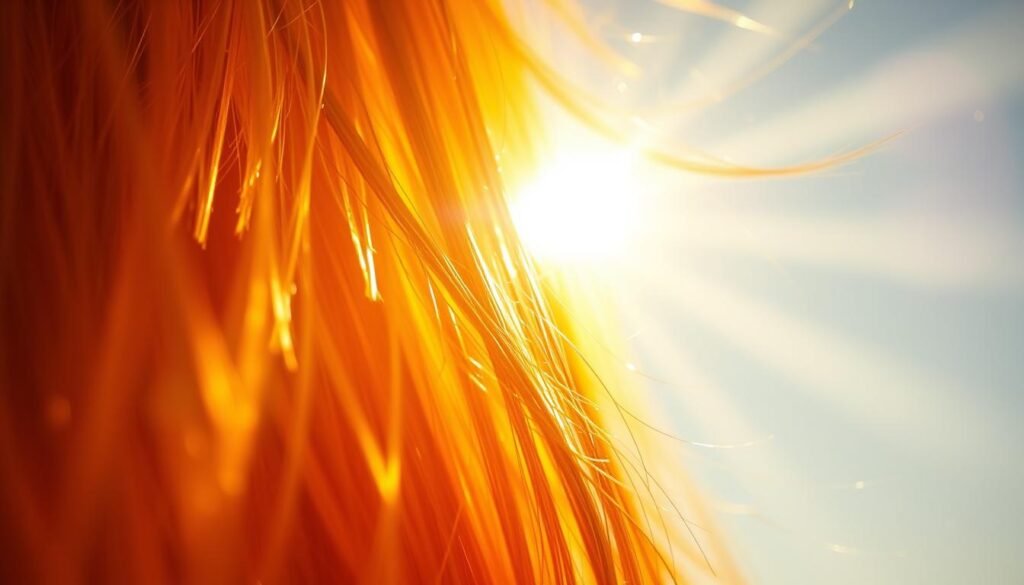
By understanding the challenges posed by environmental factors and adopting the right hair care practices, we can maintain the health and vibrancy of our hair, even in the face of modern-day stressors.
Hair Care Practices
Proper hair care practices are crucial for maintaining healthy, strong locks. However, common missteps can inadvertently lead to hair damage and breakage. From over-washing to using the wrong products, understanding the impact of our daily hair care Routines is key to preventing long-term harm.
Over-Washing Hair
Excessive hair washing can be detrimental to hair health. While most male students washed their hair twice a day, Chinese and Malay females washed their hair once a day, and Indian females washed their hair once every two days. Stripping the hair of its natural oils through frequent washing can lead to dryness, weakened cuticles, and increased susceptibility to breakage. The ideal washing frequency varies based on individual hair type and needs, so it’s essential to find the right balance to maintain optimal hair condition.
Using the Wrong Products
Choosing the right hair care products is crucial for Hair health. Male students mostly used only shampoo, while most female students used both shampoo and conditioner for hair wash. Additionally, 10% of Indian males and 25% of Indian females used coconut oil along with shampoo. Using products with harsh chemicals or incorrect pH levels can damage the hair cuticle and compromise the hair’s integrity. It’s essential to select gentle, pH-balanced products that are tailored to your specific hair type and needs to ensure optimal hair health.
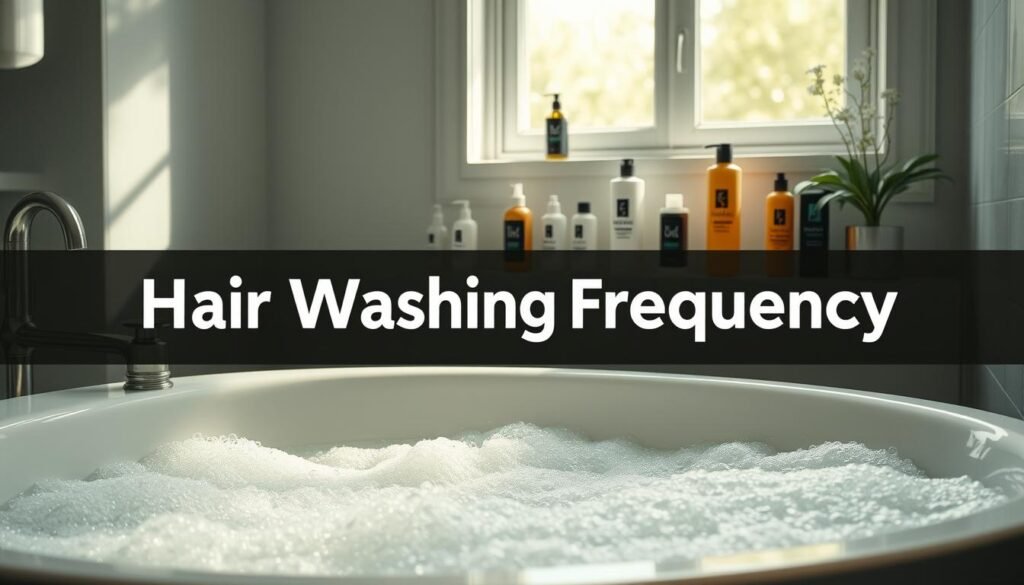
By understanding the impact of our hair care practices and making informed choices, we can protect our hair from damage and breakage, ensuring a healthy, vibrant appearance.
| Hair Care Practice | Potential Damage |
|---|---|
| Over-washing | Dryness, weakened cuticles, increased breakage |
| Using the wrong products | Damaged hair cuticle, compromised hair integrity |
| Heat exposure | Split ends, frizz, high porosity, dryness, hair loss |
| Harsh chemical treatments | Stripped natural oils and proteins, weakened hair |
| Nutritional deficiencies | Weakened hair leading to damage |
“The key to healthy, strong hair lies in our daily hair care practices. By understanding the impact of over-washing and using the wrong products, we can make informed choices to protect our locks from damage.” – Hair Care Expert
Remember, maintaining a balanced and personalized hair care routine is crucial for preventing hair breakage and preserving the health and vitality of your tresses.
Nutritional Deficiencies
Proper nutrition is essential for maintaining strong, healthy hair. Nutritional deficiencies can lead to weakened hair, making it prone to breakage and thinning. Understanding the impact of diet on hair health is crucial for achieving vibrant, lustrous locks.
Essential Nutrients for Stronger Hair
A balanced diet rich in key nutrients supports hair growth and strength. These essential vitamins and minerals include protein, iron, zinc, biotin, and vitamins A, C, and E. Ensuring adequate intake of these nutrients can help prevent hair loss and promote thicker, healthier hair.
- Protein is the building block of hair, and a deficiency can lead to thinning and breakage.
- Iron is crucial for healthy hair growth, and a deficiency can result in hair loss and anemia.
- Zinc plays a vital role in hair follicle health, and a deficiency can cause hair shedding.
- Biotin, also known as vitamin B7, is essential for keratin production and hair strength.
- Vitamins A, C, and E support scalp health and promote hair growth.
While a balanced diet is the Best way to obtain these nutrients, supplements may be necessary if dietary intake is insufficient. It’s important to consult a healthcare professional before starting any supplement regimen to ensure safety and effectiveness.

“Proper nutrition is the foundation for healthy, vibrant hair. Addressing nutritional deficiencies can be a game-changer in your hair care routine.”
The Impact of Diet on Hair Health
The foods we consume have a direct impact on the health and appearance of our hair. A diet rich in the essential nutrients for hair growth can help prevent breakage, thinning, and even hair loss. On the other hand, deficiencies in these key vitamins and minerals can lead to various hair-related issues.
| Nutrient | Recommended Daily Intake | Impact on Hair Health |
|---|---|---|
| Vitamin A | 1,300 mcg/day (4,300 IU) | Deficiency can lead to hair loss, while excess can also cause shedding. |
| Vitamin D | Not specified | Deficiency can contribute to hair loss and decreased hair density. |
| Biotin (Vitamin B7) | Not specified | Deficiency is associated with hair thinning and loss. |
| Iron | Not specified | Deficiency, common in women, can lead to hair loss. |
| Zinc | Not specified | Deficiency can result in hair loss. |
By understanding the impact of diet on hair health and addressing any nutritional deficiencies, individuals can take proactive steps to achieve stronger, more resilient hair.
Heat Styling Damage
Excessive heat styling can take a significant toll on hair health. The risks associated with frequent blow-drying are well-documented, as high temperatures can cause damage to the delicate keratin strands within the hair. In fact, any heat above 140°C can begin to degrade the hair’s structure, leading to weaker, more fragile strands over time.
Improper use of hair dryers, particularly with high heat settings, can exacerbate this issue. Exposure to the sun can also contribute to substantial hair damage, highlighting the need for effective heat and UV protection. While heat damage doesn’t directly cause hair loss, it can increase the susceptibility of hair to breakage and shedding.
The Risks of Frequent Blow-Drying
Blow-drying can be particularly damaging to hair, especially if done incorrectly or with excessive heat. The high temperatures generated by hair dryers can lead to the formation of bubbles within the hair fiber, a condition known as “bubble hair.” This irreversible damage can cause hair to feel drier, less pliable, and more brittle.
Best Practices for Heat Protection
To minimize the risk of heat-induced damage, it’s essential to adopt best practices for heat styling. Applying heat protectant products before using hot tools like straighteners or curling irons is crucial in guarding hair against UV and heat damage. Additionally, using lower heat settings, avoiding styling wet hair, and investing in high-quality ceramic styling tools can all help reduce the impact of heat on hair health.
While there’s no definitive way to repair heat-damaged hair, prevention and healthy hair care practices are key. Regular haircuts can help prevent further damage and split ends from traveling up the hair shaft. By following these guidelines, you can enjoy the benefits of heat styling while minimizing the risks to your hair’s wellbeing.
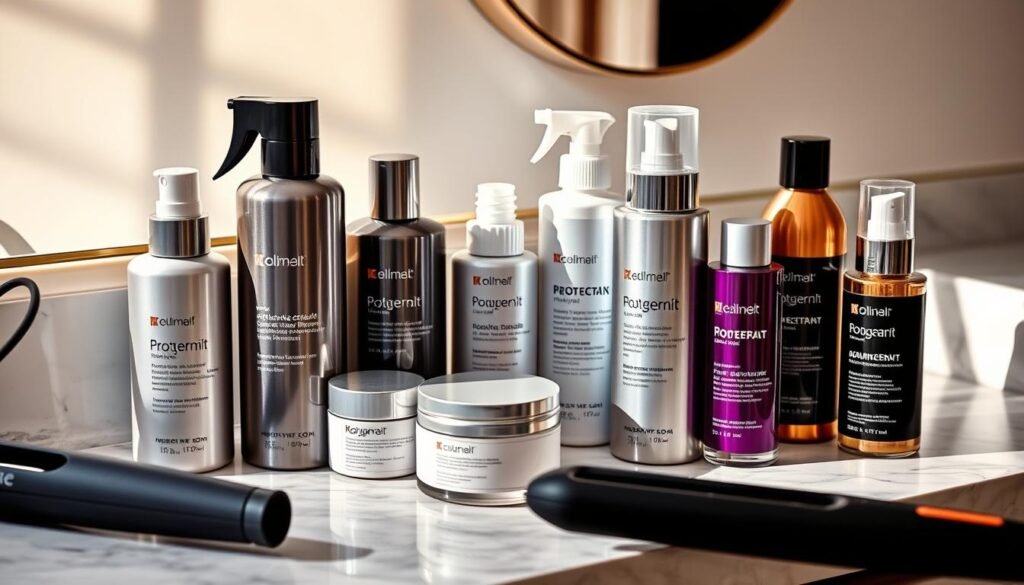
| Damage Type | Temperature Range | Effects |
|---|---|---|
| Keratin Denaturation | 392°F/200°C or more | Loss of strength and elasticity in hair |
| Color Degradation | 392°F/200°C or more | Decomposition of chromophores, leading to color changes |
| Bubble Hair | 345°F/175°C to 419°F/215°C | Gas-filled bubbles in the hair shaft, causing irreversible damage |
“Exposure to temperatures of 392°F/200°C or more initiates denaturation of keratin proteins in the cortex, leading to the loss of strength and elasticity of hair.”
Hormonal Changes
Hormonal fluctuations can have a significant impact on hair health. Conditions like hypothyroidism, wherein the thyroid gland produces insufficient hormones, can lead to hair damage and loss. Menopause, a natural transition in a woman’s life, Often results in hair thinning due to decreased estrogen levels. Managing these underlying hormonal imbalances and using targeted hair care products can help mitigate the effects of hormonal changes on hair.
Hormones and Their Effect on Hair
Hormones play a crucial role in the hair growth cycle. Imbalances in sex hormones, like testosterone and estrogen, can disrupt the normal hair follicle function and lead to conditions such as hormonal hair loss. An estimated 50 million men and 30 million women experience hormonal hair loss at a given time. Cortisol, a stress hormone, has also been linked to hair loss in women.
Menopause and Hair Thinning
The transition through menopause often brings about significant changes in a woman’s hair. Declining estrogen levels can lead to hair thinning, making the hair look less voluminous and vibrant. Oestrogens play a significant role in hair follicle changes, impacting hair growth through receptors and contributing to post-menopausal hair issues. Seeking professional guidance and using targeted hair care products can help manage these menopausal hair changes.
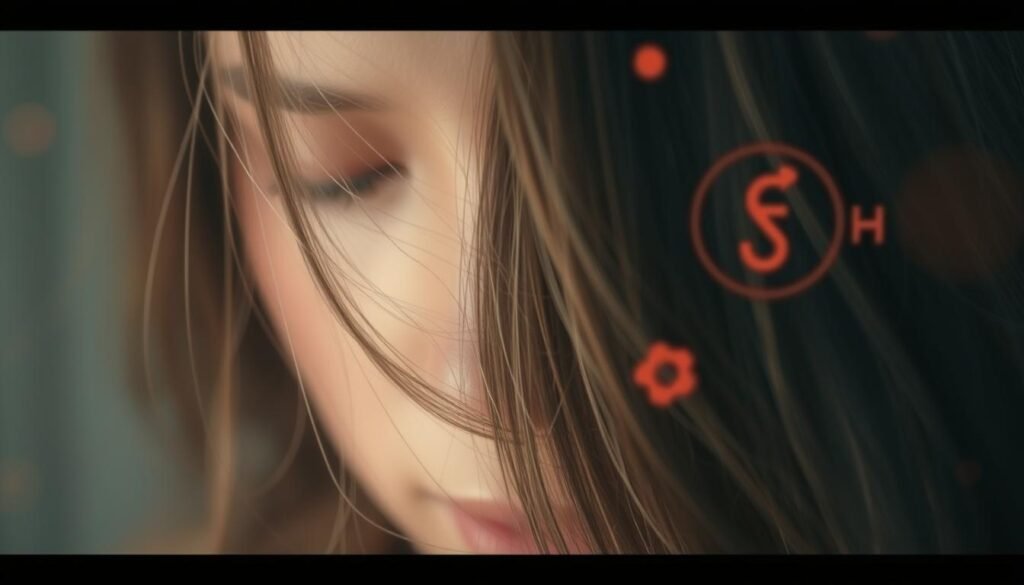
In addition to menopause, other hormonal conditions like polycystic ovarian syndrome (PCOS) and congenital adrenal hyperplasia can also contribute to hormonal hair loss. Hirsutism, or excessive hair growth, is a common symptom of PCOS, affecting 4-11% of women globally, with Asians showing a lower prevalence. Identifying and addressing the underlying hormonal imbalances is crucial for maintaining healthy, vibrant hair.
Medical Conditions
Hair loss and damage can be attributed to various medical conditions, some of which directly impact the health and growth of your strands. Understanding the underlying causes is crucial for addressing the problem effectively.
Conditions That Affect Hair Health
Autoimmune disorders like alopecia areata can cause patchy hair loss all over the body. Other conditions, such as lupus, may lead to thinning or shedding of hair. Hormonal imbalances, often seen in polycystic ovary syndrome (PCOS), can also contribute to hair damage.
Medication Side Effects
Certain medications, particularly those used for cancer treatment, arthritis, depression, and other conditions, can cause medication-induced hair damage as a side effect. Radiation therapy to the head can also result in hair loss.
If you’re experiencing unusual hair changes or loss, it’s essential to consult a healthcare professional for proper diagnosis and treatment options. With the right medical care and management, many hair-related issues can be addressed and even reversed.

Remember, your hair’s health is closely linked to your overall well-being. By understanding the potential medical causes of hair damage, you can take proactive steps to maintain a healthy, vibrant head of hair.
The Role of Genetics
Genetics play a significant role in determining hair texture, density, and susceptibility to certain types of hair loss. Genetic factors account for about 80 percent of male pattern baldness, with studies estimating that roughly 80 percent of men experience this form of hair loss by the age of 80. Similarly, about half of women will develop female pattern hair loss by the time they reach 80 years of age.
Understanding Hereditary Hair Traits
Certain genetic variations can predispose individuals to hereditary hair traits, including pattern baldness. A recent review identified 63 genes that may play a role in male pattern baldness, with only six of them found on the “X” chromosome. The AR gene, located on the “X” chromosome, is strongly associated with baldness, as those with the gene have more than twice the risk of developing male pattern baldness.
Interestingly, more than 80 percent of people experiencing noticeable balding had a father who also lost their hair, highlighting the significant hereditary component of hair loss.
Genetic Disorders Linked to Hair Loss
In addition to common hereditary hair traits, certain genetic disorders can also affect hair growth and structure. Cicatricial alopecias, a rare type of hair loss, account for 7% of all hair loss cases, with primary cicatricial alopecia (PCA) and secondary cicatricial alopecia (SCA) being the two main categories. These genetic disorders can lead to permanent scarring and hair follicle damage, resulting in irreversible hair loss.
Understanding your genetic predispositions can help in developing targeted hair care strategies. Topical medications like minoxidil (Rogaine) are often the first line of treatment for slowing down hair loss caused by genetic factors. However, addressing genetic, environmental, and lifestyle factors holistically can assist in slowing, preventing, or even reversing hair loss.
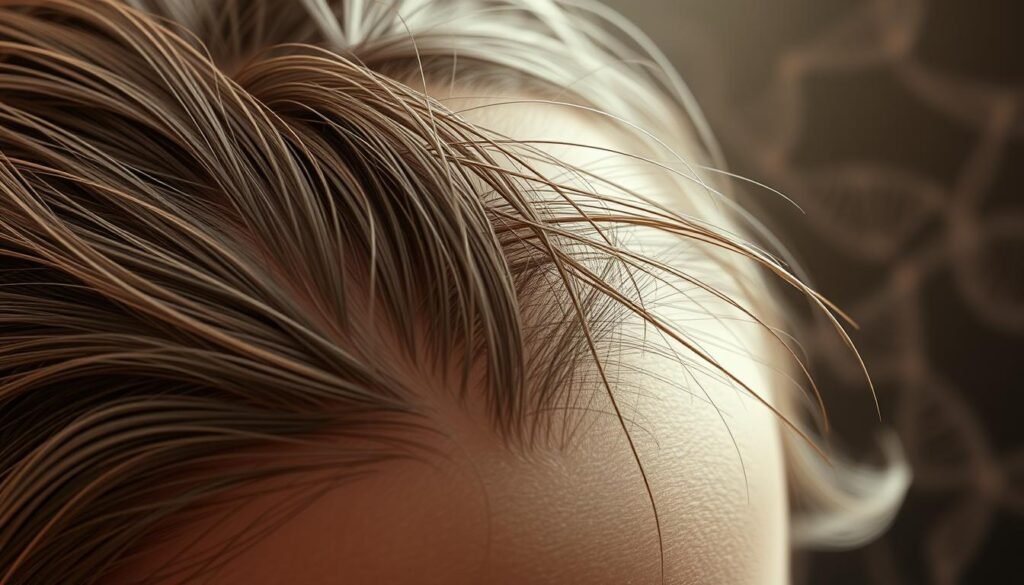
“Genetics play a significant role in hair texture, density, and susceptibility to certain types of hair loss.”
Poor Hair Hygiene
Maintaining proper hair hygiene is crucial for the health and resilience of your locks. Unfortunately, many individuals neglect their scalp care, which can have dire consequences. Infrequent washing can lead to product buildup, clogged hair follicles, and an unhealthy scalp environment, ultimately contributing to hair damage and even hair loss.
Consequences of Infrequent Washing
When you don’t wash your hair regularly, sebum, sweat, and other residues can accumulate on the scalp, leading to a host of problems. This buildup can clog hair follicles, inhibiting healthy hair growth and potentially causing scalp irritation, dandruff, and even seborrheic dermatitis.
The Importance of Scalp Care
The scalp is the foundation for healthy hair, and neglecting it can have far-reaching consequences. Conditions like autoimmune disorders, severe infections, and thyroid issues can all contribute to excessive hair loss, while factors such as pregnancy, stress, and certain medications can also trigger shedding.
To maintain a healthy scalp and promote optimal hair growth, it’s essential to establish a regular cleansing routine. Gently massaging the scalp during washing can help stimulate blood flow and dislodge any buildup, while using the right products can nourish the scalp and prevent issues like dandruff and seborrheic dermatitis.
| Scalp Condition | Causes | Symptoms | Treatment |
|---|---|---|---|
| Dandruff | Overproduction of oil, fungal infection | Flaky, itchy scalp | Anti-dandruff shampoos, medicated creams |
| Seborrheic Dermatitis | Excess oil production, fungal infection | Greasy, red, scaly scalp | Medicated shampoos, anti-inflammatory creams |
| Scalp Psoriasis | Autoimmune condition | Thick, silvery scales, redness, itching | Medicated shampoos, topical steroids |
By prioritizing scalp health and maintaining a consistent hair hygiene routine, you can help prevent damage and promote the growth of healthy, vibrant hair.
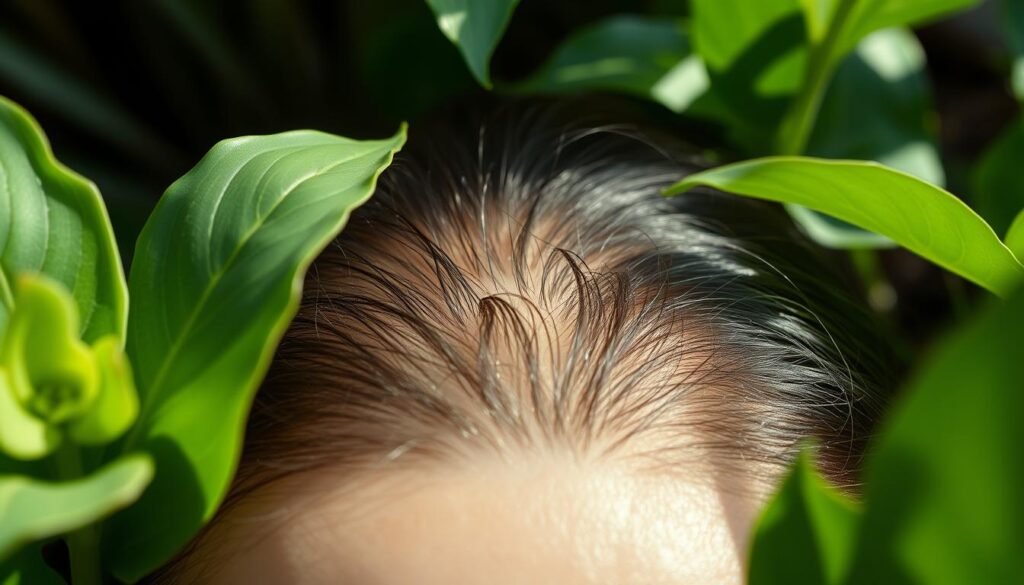
“Healthy hair starts with a healthy scalp. Neglecting your scalp care can lead to a host of problems, from dandruff to hair loss. Investing in regular cleansing and scalp treatments is essential for maintaining strong, beautiful locks.” – Dr. Sarah Mirmirani, Dermatologist
Preventing Hair Damage
Maintaining healthy, vibrant hair requires a strategic approach to hair care. To prevent hair damage, it’s essential to adopt gentle hairstyling habits and incorporate targeted treatments into your routine. Avoiding tight hairstyles, using soft hair ties, and sleeping on a silk pillowcase can help reduce friction and breakage. Regular trims every 6-8 weeks are also recommended to prevent split ends from traveling up the hair shafts and causing further damage.
Tips for Healthier Hair
Incorporating nourishing hair care products into your routine is crucial for maintaining hair health. Using leave-in conditioners and deep-conditioning hair masks can help replenish moisture and strengthen the hair fiber. Additionally, protecting hair from heat and UV damage by using heat-styling tools wisely and applying sun protection can go a long way in preserving your hair’s vibrancy.
Best Practices for Hair Maintenance
For optimal hair health, it’s important to tailor your hair care routine to your specific hair type and concerns. Textured or chemically-treated hair may require more intensive hydration and specialized treatments to prevent further damage. Establishing a consistent weekly deep treatment routine for four to six weeks can help repair existing hair damage. By incorporating these best practices into your hair care regimen, you can enjoy healthy, resilient hair that withstands the stresses of daily life.
FAQ
What causes hair damage?
Hair damage can be caused by various factors, including heat styling, chemical treatments, poor nutrition, stress, and environmental factors. Common symptoms of hair damage include frizz, dryness, and visible breakage.
What is the structure of hair?
Hair consists of three layers: the cuticle, the cortex, and the medulla. The cuticle protects the inner layers, while the cortex provides strength and determines hair color. Hair grows in cycles: anagen (growth), catagen (transition), and telogen (resting).
How does physical damage affect hair?
Excessive use of heat styling tools like flat irons and curling wands, as well as chemical treatments such as bleaching, perming, and relaxing, can weaken the hair structure and lead to breakage. Over-brushing and tight hairstyles can also cause damage.
What environmental factors can damage hair?
UV rays can weaken hair proteins and fade color, while pollution, including particulate matter and toxic gases, can accumulate on hair, leading to dryness and breakage. Protecting hair from sun exposure and using anti-pollution hair products can help mitigate environmental damage.
How can hair care practices cause damage?
Over-washing can strip hair of natural oils, leading to dryness and breakage. Using products with harsh chemicals or incorrect pH levels can also damage the hair cuticle. Choosing gentle, pH-balanced products suitable for your hair type and wash frequency can help maintain hair health.
How do nutritional deficiencies affect hair?
Nutritional deficiencies, such as a lack of protein, iron, zinc, biotin, and vitamins A, C, and E, can lead to weakened hair prone to breakage. A balanced diet rich in these essential nutrients supports hair growth and strength. Supplements may be considered if dietary intake is insufficient, but it’s best to consult a healthcare professional first.
How does heat styling damage hair?
Excessive heat styling, especially frequent blow-drying at high temperatures, can cause significant damage to the hair cuticle, leading to dryness and breakage. Using heat protectant products, lower heat settings, and limiting heat styling frequency can help minimize damage. Investing in high-quality ceramic styling tools and considering air-drying when possible can also be beneficial.
How do hormonal changes impact hair health?
Hormonal changes can significantly affect hair health. Conditions like hypothyroidism can cause hair damage and loss, while menopause often leads to hair thinning due to decreased estrogen levels. Managing underlying hormonal imbalances and using targeted hair care products can help mitigate these effects.
What medical conditions can affect hair?
Various medical conditions, including alopecia areata and lupus, can affect hair health. Certain medications, such as chemotherapy drugs, can also cause hair damage or loss as a side effect. Consulting a healthcare professional is recommended for proper diagnosis and treatment options if experiencing unusual hair changes or loss.
How do genetics influence hair?
Genetics play a significant role in hair texture, density, and susceptibility to certain types of hair loss, such as androgenetic alopecia (pattern baldness). Some rare genetic disorders can also affect hair growth and structure. Understanding your genetic predispositions can help in developing targeted hair care strategies.
How does poor hair hygiene contribute to damage?
Poor hair hygiene can lead to scalp issues, including dandruff and seborrheic dermatitis, which can contribute to hair damage. Infrequent washing can cause product buildup and clog hair follicles. Maintaining a regular cleansing routine and focusing on scalp health are crucial for promoting optimal hair growth and preventing damage.
How can I prevent hair damage?
To prevent hair damage, use gentle hair ties, avoid tight hairstyles, and use a silk pillowcase to reduce friction. Regular trims help prevent split ends, and using leave-in conditioners and hair masks can maintain moisture. Protecting hair from heat and UV damage, and considering specialized treatments for your hair type and concerns, can also help preserve hair health.
